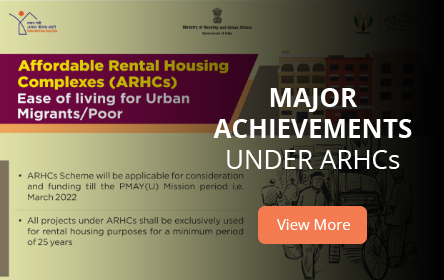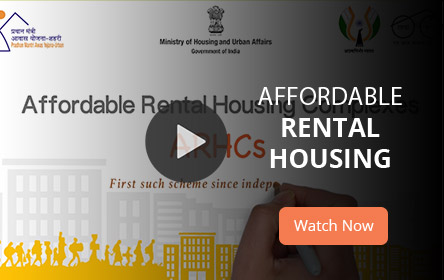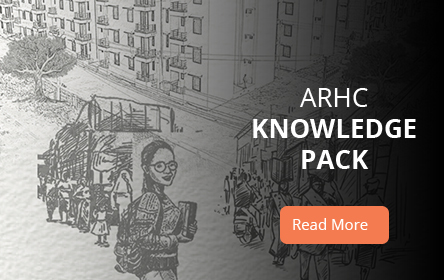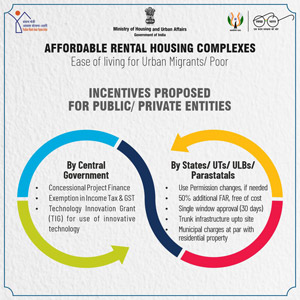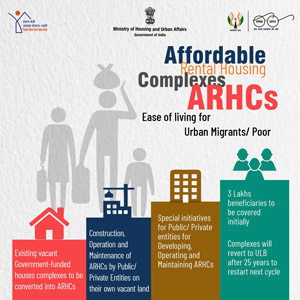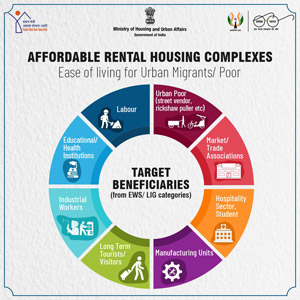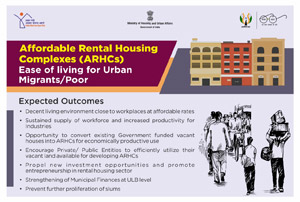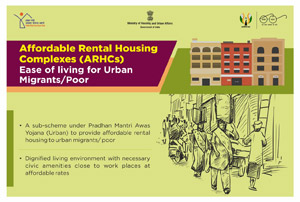AFFORDABLE RENTAL HOUSING COMPLEXES(ARHCs)
1.1 As per Census 2011, about 45 crore migrated to the different parts of the country for employment opportunities. Urban migrants consisting of workers in manufacturing industries, domestic/ commercial establishments, health sector, service providers, hospitality industry, construction or other such sectors play an important role in the urban economy. They come from rural areas or small towns for seeking better employment opportunities in urban areas. In order to maximise savings, they often compromise with living conditions to send remittances to the family left behind at their native places. Usually, they live in slums, informal/ unauthorised colonies or peri-urban areas to save rental charges. They spend lot of time on roads by walking/ cycling to workplaces, risking their lives to cut on the expenses. It also causes drudgery/ anxiety/ psychological breakdown and health problems because of compromise on rest, recuperation and hygiene conditions.
1.2 COVID-19 pandemic has resulted in massive reverse migration of workers/ urban poor in the country. This mass exodus of migrants from cities has raised concerns over economic activities. As a result, such situation has brought the issue of migrants/poor in the forefront for acknowledgment and redressal.
1.3 Housing is one of the basic necessities of life and is espoused in the Directive Principles of State Policy enshrined in the Constitution of India. A large proportion of urban migrants in all categories may already have a house or a piece of land in their respective place of domicile. They may not be interested in ownership housing in urban areas, rather would look for safer affordable rental accommodation to save on precious expenses. Provision of rental housing options closer to the place of work has potential to improve their productivity. Therefore, promoting rental housing is necessary for inclusive urban development.
1.4 Large portion of vacant land is available unutilized with Industries, Trade Associations, Manufacturing Companies, Educational/ Health Institutions, Development Authorities, Housing Boards, Central/ State Public Sector
Undertakings (PSUs) and such other Entities. Finding suitable land in the city near the centres where migrants work/ study is a big challenge. Entities having such lands have huge opportunity for construction of ARHCs. Entities are not able to utilize available land for offering housing facilities to the migrants because of restrictions posed under local planning and Development Control Regulations (DCR). Therefore, there is a need to create an ecosystem with appropriate policy initiatives by Government of India (GoI), States/ UTs/ Urban Local Bodies (ULBs)/ Parastatals through suitable provisions and incentives to enable utilization of this potential.
1.5 The vacant houses constructed for Economically Weaker Section (EWS)/ Low Income Group (LIG) under Central Government funded schemes are potentially available for utilising as rental housing for urban migrants/ poor. States/ UTs/ ULBs/ Parastatals which have developed housing complexes from their own funds, may also like to utilise their vacant housing stocks by converting them into affordable rental housing.
1.6 Post COVID-19, Government of India aims to promote economic activities through vision of "AatmaNirbhar Bharat". Therefore, MoHUA in consultation with concerned Central Ministries, States/ UTs and other stakeholders from Private/ Public Sector has initiated Affordable Rental Housing Complexes (ARHCs) for urban migrants/ poor. This initiative is being taken up for the first time in the country which will improve their living conditions and obviate the need for staying in slums/ informal settlements/ peri-urban areas etc.
a) To address the vision of 'AatmaNirbhar Bharat Abhiyan' significantly by creating a sustainable ecosystem of affordable rental housing solutions for urban migrants/ poor.
b) To achieve overall objective of "Housing for All" encompassing the need of affordable rental housing for urban migrants/ poor. ARHCs will provide them dignified living with necessary civic amenities near their place of work.
c) To create a conducive environment by incentivizing Public/ Private Entities to leverage investment for creating affordable rental housing stock to take care of their own requirements for workforce and also cater to neighboring areas, if they have available vacant land.
vi. In order to safeguard the interest of stakeholders and avoid conflict/complication, ARHCs will be kept outside the purview of existing State Rental Laws by States/UTs. ARHCs shall be governed by Model Tenancy Act (MTA) or modification of their existing laws in the line of MTA for speedy resolution.
This scheme shall follow a 3-E Strategyfor implementation of ARHCs by adopting effective and efficient mechanisms as illustrated below:
EMPOWERING STATES/UTs
EASE OF DOING BUSINESS
ENSURING SUSTAINABILITY
Model-1: Utilising Existing Government Funded Vacant Houses
a. A model RFP will be prepared and circulated by MoHUA to State/UTs. States/UTs may customize and publish the RFP as per their requirements for selection of Concessionaire through State/UT e-Procurement Portal/ Govt. of India e-procurement portal.
b. Concessionaire will be selected through transparent bidding process, with rent and period of concession as fixed parameters and bidding on Highest Positive Premium to ULBs or Lowest Negative Premium through Viability Gap Funding (VGF).
c. Concessionaire will Repair/ Retrofit the houses/building and fill up civic infrastructure gaps like water, sewer/ septage, sanitation, internal road etc. to make it liveable. Thereafter, these will be Developed as ARHCs and Operate for the concession period i.e. 25 years. Concessionaire will Transfer these complexes to the ULBs after 25 years. Thereafter, ULB may restart next cycle like earlier or operate the complexes on their own.
d. Necessary Social Infrastructure (e.g. health centre, anganwadi, creche, community centre etc.) and Neighbourhood Commercial (e.g. street shops, grocery store, medical shops, milk booths, ATM etc.) will also be developed by Concessionaire as per the requirement.
e. Initial affordable rent of ARHCs will be fixed by the local authority based on a local survey, prior to the issuance of Request for Proposal (RFP) by ULBs. Subsequently, rent will be enhanced biennially by 8%, subject to maximum increase of 20% in aggregate, over a period of 5 years, effective from the date of signing the contract. Same mechanism shall be followed over the entire concession period i.e. 25 years.
f. Following incentives to be extended by Government of India and States/ UTs/ ULBs to Entities to develop and operate ARHCs:
1) Exemption of Income Tax on any profits and gains derived from the operation of ARHCs on the similar lines as that for 'Affordable Housing' under section 80-IBA of Income Tax Act, 1961.
2) Exemption of GST on any profits and gains derived from operation of ARHCs at par with rental services of residential premises, vide Notification number 12 of 2017- Central Tax (Rate) dated 28th June 2017.
3) Concessionaire shall receive project finance/loan at lower interest rate through concessional window under Affordable Housing Fund (AHF) by Housing Finance Companies (HFCs) and Priority Sector Lending (PSL) by Commercials Banks, upon inclusion of ARHCs in Harmonized Master List (HML) on the same lines of 'Affordable Housing'.
1) Single window system for approval of design/ drawings and other statutory approvals within 30 days, after which proposed project will be considered as deemed approved for construction.
2) Trunk infrastructure facilities like road, sanitation services, water, sewerage/ septage, drainage etc. to be provided.
3) Municipal services such as water supply, electricity, house/ property tax, sewerage/ septage charge etc. to be levied at par with the residential projects.
g. States/ UTs/ ULBs/ Parastatals which utilise their vacant EWS/ LIG housing complexes developed from own funds by converting them into ARHCs under PPP mode through Concessionaire or by public agencies, will be eligible for similar incentives/ benefits as above.
Model-2: Construction, Operation and Maintenance of ARHCs by Private/ Public Entities on their own available vacant land
a) MoHUA will issue an Expression of Interest (EoI) where Entities would submit their application with necessary documents on dedicated web portal of ARHC. The applications will be downloaded by concerned States/UTs/ULBs for shortlisting the Entities, based on eligibility criteria defined in EoI document.
b) Shortlisted Entities shall submit Detailed Project Report (DPR) to the respective ULBs for further processing and upload a copy of DPR on ARHC website.
c) Entities to Construct, Operate and Maintain ARHCs on their own available vacant land themselves for 25 years.
d) ARHCs constructed through this model will consist of a mix of Dwelling Unit (DU) (up to 30/60 sqm carpet area each) and Dormitory of 4/6 beds (up to 10 sqm carpet area per bed) including all common facilities, the ratio of which may vary as required. Minimum size of dwelling units (single/double bedroom) and dormitories shall conform to the requirement of National Building Code (NBC) and State/ Local Authority norms.
e) A single project of ARHC shall have at least 40 DU (double bedroom/ Single bedroom) or equivalent dormitory beds (1 Single bedroom unit of upto 30 sqm carpet area is considered equivalent to 3 Dormitory beds). There will be complete flexibility to private/public entities to have any mix of single/double bedroom and dormitories (4/6 units). However, to ensure that such complexes are used for urban migrant/poor of EWS/LIG category and not misused for any other purposes, a ceiling of maximum 1/3 dwelling units (33%) in double bedroom form in any project of ARHCs has been provisioned. For example, if total number of units in one project is 120, the Entity may have any combination of single bedroom/ double bedroom/ dormitory bed, but number of double bed rooms cannot be more than 40. The prospective agencies/entities may propose DUs/Dormitories as follows:
| Type of DUs | Carpet Area (sqm) | Unit Structure | Ratio under ARHCs |
| Single Bedroom | Up to 30 | 1 bedroom, living room, kitchen, bathroom, toilet etc. |
Ratio of DUs and dormitory beds may vary as per project requirement. |
| Dormitory | Up to 10 | Separate bed, side table, shelves, lockers, common facilities of kitchen, toilet etc. |
|
| Double Bedroom | Up to 60 | 2 bedroom, living room, kitchen, bathroom, toilet etc. |
A maximum of one-third (33%) of total DUs in the project is permissible as ARHCs. |
f) Initial, affordable rent of ARHCs will be fixed by Entity as per local survey. Subsequently, Entity can increase rent biennially at 8%, subject to maximum increase of 20% in aggregate, over a period of 5 years, effective from the date of signing contract. Same mechanism shall be followed over the entire concession period i.e. 25 years.
g) Entity can partner/ associate with other Entities for land arrangement, project financing, project management etc. to develop the ARHCs.
h) For sustained occupancy and continued revenue, Entity may tie up with other Entities/Organizations or get migrant labour/ urban poor through Aggregators. Rent may be remitted by such agencies deducting directly from the salary/ fee/ any kind of remuneration etc. of tenants.
i) Following incentives to be extended by Government of India and States/ UTs/ ULBs to Entities to develop and operate ARHCs:
1) Exemption of Income Tax on any profits and gains derived from the operation of ARHCs on the similar lines as that for 'Affordable Housing' under section 80-IBA of Income Tax Act, 1961.
2) Exemption of GST on any profits and gains derived from operation of ARHCs at par with rental services of residential premises, vide Notification number 12 of 2017- Central Tax (Rate) dated 28th June 2017.
3) Entity Shall receive project finance/loan at lower interest rate through concessional window under Affordable Housing Fund (AHF) by Housing Finance Companies (HFCs) and Priority Sector Lending (PSL) by Commercials Banks, upon inclusion of ARHCs in Harmonized Master List (HML) on the same lines of 'Affordable Housing'.
4) TIG will be provided for adopting identified innovative technologies to expedite construction and delivery of ARHCs.
1) Provision for "Use Permission" changes for houses for the vacant land.
2) 50% additional Floor Area Ratio (FAR)/ Floor Space Index (FSI) free of cost through necessary changes in the DCR.
3) Single window system for approval of design/ drawings and other statutory approvals within 30 days, after which proposed project will be considered as deemed approved for construction.
4) Trunk infrastructure facilities like road, sanitation services, water, sewerage/ septage, drainage etc. to be provided.
5) Municipal services such as water supply, electricity, house/ property tax, sewerage/ septage charge etc. to be levied at par with the residential projects.
a) The concept of ARHCs has been initiated to address the emergent requirements of rental housing for urban migrants within the larger ambit of PMAY (U). The arrangement for third party/ independent evaluation will be done as per the operational guidelines of ARHCs.
b) Monitoring and evaluation of the scheme will be done by MoHUA and the concerned State/UT government and take suitable measures for smooth implementation of the scheme in a time bound manner.
c) A Mid-term evaluation of the scheme will be carried out by MoHUA as per existing guidelines for appraisal of Centrally/Central sector schemes. In addition, Social Audit of the scheme will be conducted through a third party, as selected by MoHUA.
d) MoHUA will develop a dedicated online ARHC web portal for the purpose of documentation, knowledge sharing and management at national level. The State/ULB/Parastatals will upload the details of such projects on this website.
e) The concerned ULB/ Parastatals will be responsible for overall management of the ARHC projects including the listing of all projects under ARHCs.
f) Concessionaire/ Entity shall submit 'Project Compliance Report' to concerned ULB on quarterly basis for monitoring the implementation as per the scheme guidelines.
a) The urban migrant/ poor will get better and decent living environment through creation of ARHCs near their workplaces.
b) It would provide an opportunity and enabling framework for States/ UTs to convert vacant housing stocks constructed from their own funds into ARHCs.
c) Vacant housing stock of Central/State/UT Government funded will be converted into ARHCs for economically productive use.
d) Industries will be benefitted through sustained supply of workforce.
e) Dignified living conditions of migrant labour/ poor will result in improved productivity and workmanship for eventual economic gain.
f) This will help in achieving the objective of "Housing for All", catering the need of rental housing for urban migrants/ poor who do not seek ownership.
g) It would create a conducive environment for Entities to develop AHRCs on their own available vacant land which will propel new investment opportunities and promote entrepreneurship in rental housing sector.
h) It would create an enabling environment for Public/ Private Entities to offer their vacant land for such entrepreneurial opportunity of developing ARHCs, which would propel further investment.
i) Promoting affordable rental housing will ensure inclusive urban development by providing liveable housing options to the urban migrants/ poor at reasonable rent and encourage prevention of future unplanned growth of slums.
Follow PMAY(Urban)
Contact Us
Ministry of Housing and Urban Affairs
Nirman Bhawan, New Delhi-110011
Phone No: 011-23063285,011-23060484
Email: pmaymis-mhupa@gov.in (link sends e-mail)
Website: https://pmay-urban.gov.in/




